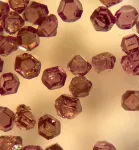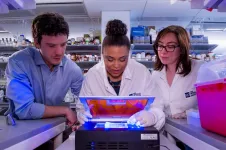(Press-News.org) Indigenous people have lived in the Bears Ears region of southeastern Utah for millennia. Ancestral Pueblos built elaborate houses, check dams, agricultural terraces and other modifications of the landscape, leaving ecological legacies that persist to this day. Identifying how humans interacted with past environments is critical for informing how best to protect archaeological sites and ecological diversity in the present. This "archaeo-ecosystem" approach would facilitate co-management of public lands in ways that promote Indigenous health, cultural reclamation and sovereignty.
For the first time, a new study evaluated ecological legacies, archaeo-ecosystem restoration and Indigenous co-management practices in the Bears Ears region on the Colorado Plateau. The study published on May 17, 2021 in the journal Proceedings of the National Academy of Sciences.
"Bears Ears is not just about boundaries, it's about management," said the study's lead author Bruce Pavlik, director of conservation at Red Butte Garden. "And it's not just about artifacts. It's also about the archaeo-ecosystems that are there. That's what's sacred to Native people."
The authors surveyed 25 archaeological sites in the Bears Ears region that represented a wide range of locations, environments and archaeological complexity. By collecting plant specimens found at those sites, they compiled a list of 117 culturally significant plant species--those used for food, medicinal, ceremonial and utilitarian purposes by the Hopi Tribe, Ute Mountain Ute Tribe, Apache Tribe, Pueblo of Zuni and the Navajo (Diné) Nation who trace ancestry to or currently reside in the region. They found that dense concentrations of archaeological features, probably the result of larger populations of people, had a higher diversity of culturally significant plant species called ethnographic species richness. The implication is that people left behind those plants as a living legacy, either through intentional propagation or accidental release when they discarded unused seeds or fruits.
"The medicines on the landscape all have a story," said co-author Cynthia Wilson, director of the Traditional Foods Program for Utah Diné Bikéyah and member of the Navajo (Diné) Nation. "The original proposal to designate 1.9 million acres for Bears Ears National Monument came from listening to the elders and medicine people who mapped culturally significant plants to protect our narratives. In terms of management, traditional knowledge is crucial to protect the entire ecosystem as a cultural living landscape. Our ancestors tended to these ancient gardens that warrant special management regime. Right now, there's no real security to prevent damage."
Co-author Arnold Clifford, renowned botanist at Carrizo Mountain Environmental & Herbarium, Inc., and member of the Navajo (Diné) Nation, noted that seven plant species that occurred within these Bears Ears sites are held as sacred as lifeway medicines. Some plant species found at archaeological sites, such as sagebrush and pinyon pine, are common across the landscape. However, at least 31 plant species were extremely rare outside of the habitation structures, including the Four Corners potato (Solanum jamesii), a native tuber that is an important medicine and food source.
"In other words, the plants weren't randomly just there," said Pavlik. "People brought propagules of the species in with them. This is one of the rare times in the archaeological literature where people invested in native species and brought them to their habitations. It indicates this higher level of landscape manipulation, what we call an ecological legacy of past human occupation."
Using data on known archaeological sites from Utah's State Historic Preservation Office, co-author Brian Codding, anthropologist and director of the University of Utah Archaeological Center, worked with anthropology Ph.D. students Peter Yaworsky and Kenneth B. Vernon to develop a statistical model assessing botanical richness based on archaeological and environmental variables for an additional 240 archaeological sites across the Bears Ears region.
"We used what we recorded in the field to project our findings across the whole region," Codding said. "The model can help Tribal and federal land managers identify places that need the most protection to preserve complex archaeological sites and important plant species."
Effective stewardship of the Bears Ears region will require special management policies applied to these botanically and culturally rich archaeo-ecosystems. A blend of western science and deep Indigenous ecological knowledge can be used to mitigate the effects of increased visitation, proposed development and expanded resource extraction.
"What Tribal members have said all along is that you don't just preserve the archaeological site," said Lisbeth Louderback, curator of archaeology and director of the archaeobotany lab at the Natural History Museum of Utah and anthropologist at the University of Utah. "You have to preserve the entire resource space around the site, including the plants. Building a management plan incorporating both western science and traditional knowledge will get a full picture of the best way to take care of the resources and the monument."
"The knowledge that came from this publication is not only an important contribution to Bears Ears, but also to Grand Staircase-Escalante National Monument," Wilson said. "The ancestral Pueblo people travelled long distances to transport, trade and take care of plants like the Four Corners potato across the region and they have left these seeds for us to continue taking care of today."
INFORMATION:
There are roughly 50 billion individual birds in the world, a new big data study by UNSW Sydney suggests - about six birds for every human on the planet.
The study - which bases its findings on citizen science observations and detailed algorithms - estimates how many birds belong to 9700 different bird species, including flightless birds like emus and penguins.
It found many iconic Australian birds are numbered in the millions, like the Rainbow Lorikeet (19 million), Sulphur-crested Cockatoo (10 million) and Laughing Kookaburra (3.4 million). But other natives, like the rare Black-breasted Buttonquail, only have around 100 members left.
The findings are being published this week in the Proceedings ...
Scientists studying the impact of record heat and drought on intact African tropical rainforests were surprised by how resilient they were to the extreme conditions during the last major El Niño event.
The international study, reported in Proceedings of the National Academy of Sciences today, found that intact rainforests across tropical Africa continued to remove carbon from the atmosphere before and during the 2015-2016 El Niño, despite the extreme heat and drought.
Tracking trees in 100 different tropical rainforests across six African countries, the researchers found that intact forests across the continent still removed 1.1 billion tonnes of carbon dioxide per year from the atmosphere during the El Niño monitoring ...
Researchers at Baylor College of Medicine have followed the progression of breast cancer in an animal model and discovered a path that transforms a slow-growing type of cancer known as estrogen receptor (ER)+/HER2+ into a fast-growing ER-/HER2+ type that aggressively spreads or metastasizes to other organs.
The study, which appears in the Proceedings of the National Academy of Sciences, has implications for breast cancer therapy as it suggests the need to differentiate cancer subtypes according to the path the cells follow. Different paths might be linked to different cancer behavior, which should be taken into consideration to plan treatment appropriately.
"In ...
Scientists have detected new early-warning signals indicating that the central-western part of the Greenland Ice Sheet may undergo a critical transition relatively soon. Because of rising temperatures, a new study by researchers from Germany and Norway shows, the destabilization of the ice sheet has begun and the process of melting may escalate already at limited warming levels. A tipping of the ice sheet would substantially increase long-term global sea level rise.
"We have found evidence that the central-western part of the Greenland ice sheet has been destabilizing and is now close to a critical transition," explains lead author Niklas ...
A new technology developed by UZH researchers enables the body to produce therapeutic agents on demand at the exact location where they are needed. The innovation could reduce the side effects of cancer therapy and may hold the solution to better delivery of Covid-related therapies directly to the lungs.
Scientists at the University of Zurich have modified a common respiratory virus, called adenovirus, to act like a Trojan horse to deliver genes for cancer therapeutics directly into tumor cells. Unlike chemotherapy or radiotherapy, this approach does no harm to normal healthy cells. Once inside tumor cells, the delivered genes serve as a blueprint for therapeutic ...
When doctors or scientists want to peer into living tissue, there's always a trade-off between how deep they can probe and how clear a picture they can get.
With light microscopes, researchers can see submicron-resolution structures inside cells or tissue, but only as deep as the millimeter or so that light can penetrate without scattering. Magnetic resonance imaging (MRI) uses radio frequencies that can reach everywhere in the body, but the technique provides low resolution -- about a millimeter, or 1,000 times worse than light.
A University of California, Berkeley, researcher has now shown that microscopic ...
PHILADELPHIA and MELBOURNE, Australia -- (May. 17, 2021) -- A team of scientists from The Wistar Institute in Philadelphia and the Peter MacCallum Cancer Center in Melbourne, Australia, discovered a new checkpoint mechanism that fine-tunes gene transcription. As reported in a study published in Cell, a component of the Integrator protein complex tethers the protein phosphatase 2A (PP2A) to the site of transcription allowing it to stop the activity of the RNA polymerase II enzyme (RNAPII). Disruption of this mechanism leads to unrestricted gene transcription and is implicated in cancer.
The study points to new viable opportunities for therapeutic ...
Exposure to light is compulsory for photosynthetic organisms for the conversion of inorganic compounds into organic ones. However, if there is too much solar energy, the photosystems and other cell components could be damaged. Thanks to special protective proteins, the overexcitation is converted into heat - in the process called non-photochemical quenching. The object of the published study, OCP, was one of such defenders. It was first isolated in 1981 from representatives of the ancient group of photosynthetic bacteria, ?yanobacteria. OCP comprises two domains forming a cavity, in which a carotenoid pigment is embedded.
"When light is absorbed by the carotenoid molecule, OCP can change from an inactive orange to an active red form. ...
For much of the nation's food supply, removing unsafe products off of store shelves can take up to 10 months, according to news reports -- even when people are getting sick.
The growing complexity and scope of modern supply chains result in painfully slow product recalls, even when consumer well-being is at stake. For example, in 2009, salmonella-tainted peanuts killed nine people and sickened more than 700 in 46 states, and the resulting nationwide recall cost peanut farmers, their wholesale customers and retailers more than $1 billion in lost production ...
Viruses attack the body by sending their genetic code -- DNA and RNA -- into cells and multiplying. A promising class of therapeutics that uses synthetic nucleic acids to target and shut down specific, harmful genes and prevent viruses from spreading is gaining steam.
However, only a handful of siRNA, or other RNA interference-based therapeutics have been approved. One of the main problems is getting the siRNA into the body and guiding it to the target.
Chemical engineering researchers in the Cockrell School of Engineering aim to solve that problem, while improving the targeting effectiveness of siRNA. In a new paper in the Journal of Controlled Release, the researchers created several different types of nanoparticles and analyzed them for the ability to deliver and protect siRNA from ...






